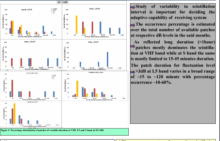IRNSS scintillation studies near the EIA crest of the Indian longitude Sector
Debasis
Jana
University of Calcutta
Poster
Scintillation of trans ionospheric signals at S(2492.08 MHz) and L5(1176.45 MHz) bands from satellite constellation of Indian Regional Navigation Satellite System(IRNSS) along with scintillation at L1(1575.42 MHz) band from available SBAS(GAGAN, BieDou, MTSAT) links and VHF(250.650 MHz) band from FSC are investigated to study the multi-frequency and multi-satellite occurrence features in the context of navigation. The observation are made from Raja Peary Mohan College(22.660 N, 88.40 E) located virtually below the northern crest of the Equatorial Ionization Anomaly(EIA) during the period April2015 to April2017. The results of analysis indicates occurrence to severe scintillation in the VHF to lower microwave L bands during equinoctial months high solar activity period while the scintillation at S band is mostly limited to 10dB fluctuations While multiple scattering , appearance of dual slope, lowest coherence length characterizes the VHF to L band scintillation, single scattering dominates the scitillation at S band. A study of CDF leads to fade margin of 14dB at L5 band while the same at S band estimated to be 6dB for faithfull navigation below the saturation limits. There are periods when multi-satellite trans ionospheric links located within the 1Oo span of IPPs (satellites located between 55oE IRNSS and 145oE MTSAT) exhibit scintillation simultaneously. The period is also permeated by loss of lock in the different GNSS links. During the period availability of GNSS links(GPS, GLONASS etc) attains a value of less than 4, minimum requirement for faithful navigation. Analysis of Total Electron Content(TEC) data of the various GNSS tracks reveal severe depletion along with high value of ROTI, evolution and shifting of wavelet structure pattern of multiple periods in detrended TEC during multi satellite scintillation. The result may be discussed in terms of evolution of cluster of equatorial plasma bubbles and its superposition in the post sunset period of equinoctial months.

Poster PDF